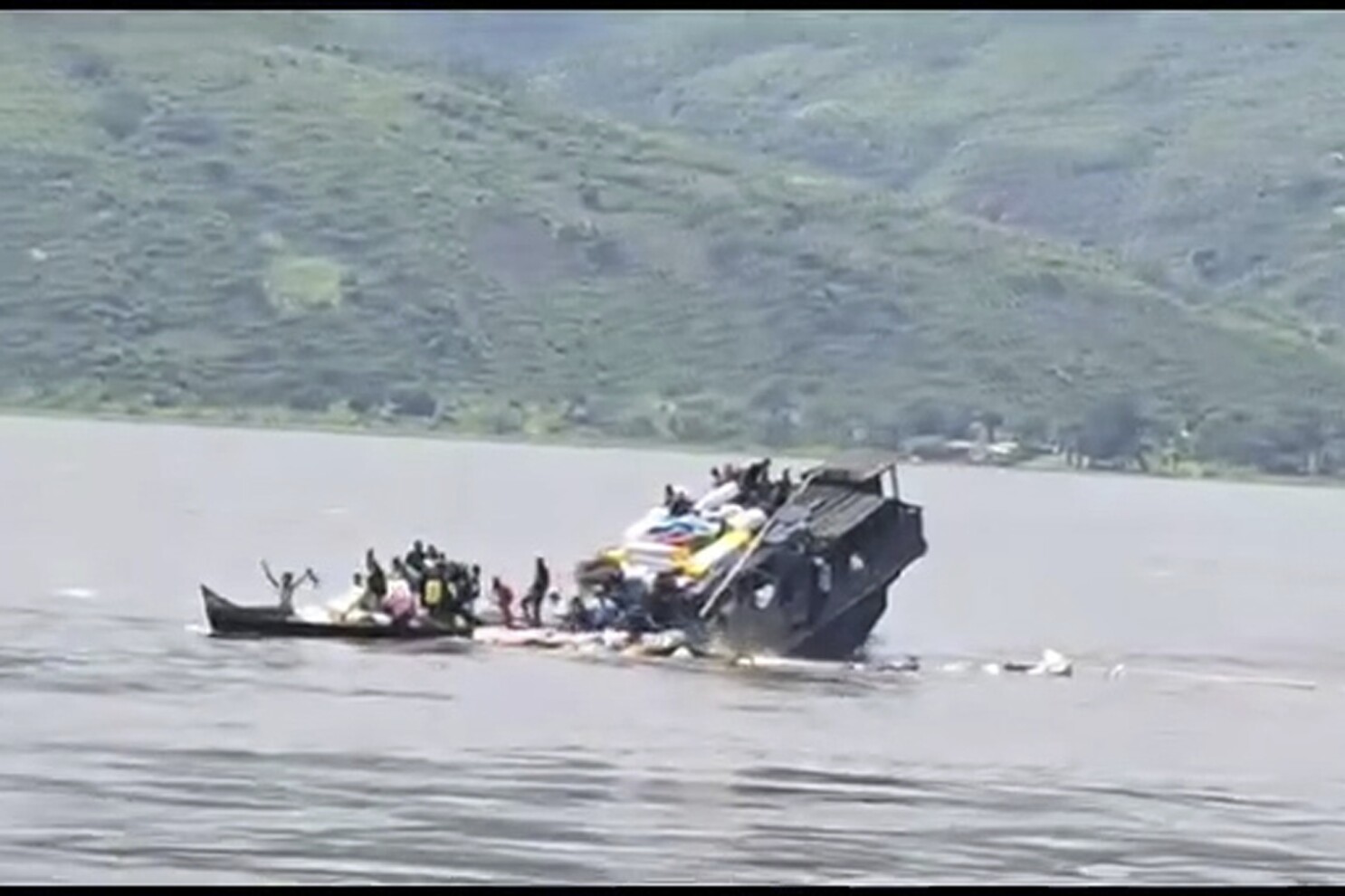Lake Kivu Horror: At least 78 people have tragically lost their lives after a ferry capsized in the eastern Democratic Republic of Congo (DRC). The boat, carrying 278 passengers, was just a few hundred meters from its destination when it sank near the shores of Goma early on Thursday morning. This catastrophic incident highlights the ongoing dangers of overcrowded boats in the region.
Ferry Overloaded and Sinks Near Goma
The ill-fated boat had departed from Minova, a town in South Kivu, en route to Goma. Eyewitnesses and survivors described the ferry as severely overloaded, a common issue in the DRC’s water transport system.
A video circulating online shows the ferry tipping to one side before it finally submerges. The Lake Kivu Horror has left families devastated as they await news of their missing loved ones.
Jean Jacques Purisi, the regional governor, confirmed that there were 278 passengers onboard, though the number of missing persons remains unclear. “It will take at least three days to get the exact numbers because not all the bodies have been found yet,” Governor Purisi stated in an interview with Reuters. Rescue teams are still working around the clock to recover more bodies from the Lake Kivu Horror.
Survivor’s Account: “I Saw Women and Children Sinking”
Survivors from the ferry disaster shared haunting accounts of their experiences. Alfani Buroko Byamungu, a 51-year-old man who narrowly escaped death, recounted the horror of the situation. “I saw people sinking; many went under. I saw women and children sinking in the water. I was on the verge of drowning, but God helped me.
Another witness to the tragedy, Aaron Ashuza, a local activist, described seeing the bodies being pulled from the lake. He emphasized the overwhelming sorrow of the community, further underlining the grief surrounding this Lake Kivu Horror.
Dangerous Conditions: Overloaded Ferries and Poor Safety Standards
Ferry accidents like the Lake Kivu Horror are all too frequent in the DRC, mainly due to a lack of stringent safety standards. Many ferries are allowed to operate while heavily overloaded, and passengers are often not provided with life jackets—a key safety measure. The absence of proper safety precautions and the fact that many passengers are non-swimmers significantly increase the risk of such tragedies.
Bahati Selemani, a dock worker involved in the rescue operations, noticed the boat was overcrowded. “We saw that the boat was very overloaded, and there were also strong waves. After that, the boat started to capsize little by little,” he told **AP news agency**. Selemani explained how those on the upper decks of the boat attempted to save themselves by jumping into the water as the ferry capsized.
Missing Passenger Manifest Complicates Rescue Operations
One of the major challenges in dealing with ferry accidents like the Lake Kivu Horror is the lack of accurate passenger manifests. Many ships operating in the DR Congo fail to record the exact number of passengers on board. This makes it almost impossible for rescuers to know how many people are missing following an accident. In this case, rescue operations have been significantly hampered due to the incomplete passenger list.
Search teams continued their efforts on Lake Kivu, scouring the waters in hopes of recovering the remaining victims. However, the scale of the Lake Kivu Horror has raised serious concerns about the safety and regulation of the ferry system in DR Congo.
DR Congo’s Troubling History of Ferry Disasters
The Lake Kivu Horror is only the latest in a series of ferry disasters that have plagued the DR Congo over the years. With boats frequently overloaded and essential safety regulations ignored, such accidents are tragically common. The country’s vast waterways, including Lake Kivu and the Congo River, serve as vital transportation routes but also pose significant risks to those travelling on them.
A similar accident in 2019 resulted in over 150 deaths on Lake Kivu, drawing attention to the ongoing problem. The Lake Kivu Horror has reignited calls for action, as the lack of safety enforcement continues to threaten the lives of thousands of people who rely on these water routes for daily transport.
Government Response and Calls for Reform
As the rescue efforts unfold, mounting pressure is on the Congolese government to address the systemic issues contributing to such accidents. Survivors, families of the victims, and local activists are demanding immediate reforms to ensure that tragedies like the Lake Kivu Horror do not continue.
The failure to enforce safety regulations has led to repeated disasters, with each incident leaving behind a trail of mourning families.
Due to the limited resources of the Congolese government, regulatory oversight has been minimal, particularly in the water transport sector. However, following the widespread attention brought by the Lake Kivu Horror, there is renewed hope that the government will take necessary action to protect its citizens from further harm.
Local Communities Grieving Over the Lake Kivu Horror
The impact of the Lake Kivu Horror on local communities has been immense. Families are still waiting to receive news of their loved ones, unsure if they are among the victims. Many have gathered near the shores of Lake Kivu, praying and hoping for a miracle as search teams continue to recover bodies from the water.
Speaking to the BBC, local activist Aaron Ashuza described the community’s overwhelming sorrow. “People are grieving deeply here. The entire community has been affected by this tragedy. The Lake Kivu Horror has changed many lives forever,” he said.








